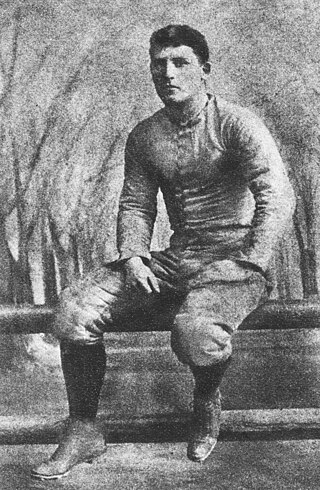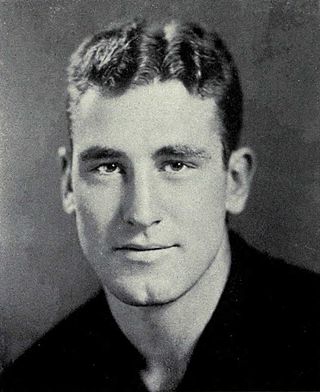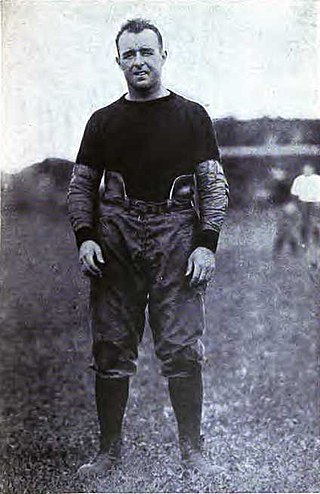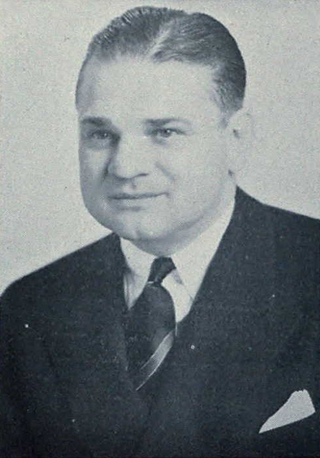
Amos Alonzo Stagg was an American athlete and college coach in multiple sports, primarily American football. He served as the head football coach at the International YMCA Training School (1890–1891), the University of Chicago (1892–1932), and the College of the Pacific (1933–1946), compiling a career college football record of 314–199–35 (.605). His undefeated Chicago Maroons teams of 1905 and 1913 were recognized as national champions. He was also the head basketball coach for one season at Chicago (1920–1921), and the Maroons' head baseball coach for twenty seasons.

Fielding Harris Yost was an American college football player, coach and athletics administrator. He served as the head football coach at: Ohio Wesleyan University, the University of Nebraska, the University of Kansas, Stanford University, San Jose State University, and the University of Michigan, compiling a coaching career record of 198–35–12. During his 25 seasons as the head football coach at Ann Arbor, Yost's Michigan Wolverines won six national championships, captured ten Big Ten Conference titles, and amassed a record of 165–29–10.

Clark Daniel Shaughnessy was an American football coach and innovator. He is sometimes called the "father of the T formation" and the original founder of the forward pass, although that system had previously been used as early as the 1880s. Shaughnessy did, however, modernize the obsolescent T formation to make it once again relevant in the sport, particularly for the quarterback and the receiver positions. He employed his innovations most famously on offense, but on the defensive side of the ball as well, and he earned a reputation as a ceaseless experimenter.

George Edkin Little was an American football player, and coach of football, basketball, and baseball, and college athletics administrator.
William Phillip Dickens was an American football player, coach of football, basketball and baseball, and college athletics administrator. He served as the head football coach at Wofford College (1947–1952), the University of Wyoming (1953–1956), and Indiana University Bloomington (1958–1964), compiling a career record of 89–68–10. Dickens was also the head basketball coach at Wofford for one season in 1941–42, tallying a mark of 10–14, Wofford' head baseball coach for two seasons, from 1941 to 1942, and the school's athletic director from 1947 to 1952.

Ivan B. "Ivy" Williamson was a player and coach of American football and basketball, and a college athletics administrator. He played college football and basketball at the University of Michigan from 1930 to 1932 and was captain of the national champion 1932 Michigan football team. He was an assistant football coach at Yale University and the head football coach at Lafayette College (1947–1948) and the University of Wisconsin–Madison (1949–1955). He served as the athletic director at Wisconsin from 1955 to 1969.
Oliver Joel "Lil' Joel" Hunt was an American football and baseball player and coach of football. He played college football at Texas A&M University from 1925 to 1927 and served as the head football coach at the University of Georgia in 1938 and the University of Wyoming in 1939. Hunt also played professional baseball in the minor leagues and briefly with the St. Louis Cardinals of Major League Baseball. He was inducted into the College Football Hall of Fame as a player in 1967.

James Wilson Aiken was an American football player and coach of football and basketball. He served as the head football coach at the University of Akron (1936–1938), the University of Nevada (1939–1946), and the University of Oregon (1947–1950), compiling a career college football record of 78–53–5. Aiken was also the head basketball coach at Nevada for a season in 1944–45, tallying a mark of 8–9.
Jacob Neil "Skip" Stahley was an American college football coach and athletic director. He served as the head coach at the University of Delaware in 1934, Brown University from 1941 to 1943, George Washington University from 1946 to 1947, the University of Toledo from 1948 to 1949, and the University of Idaho from 1954 to 1961. Stahley was the athletic director at Idaho from 1960 to 1964 and Portland State University from 1964 to 1972.

Charles Edward Brickley was an American football player and coach. He was a two-time All-American at Harvard and set college football records for career and single-season field goals. He then served as the head football coach at the Johns Hopkins University in 1915 and Boston College from 1916 to 1917 and coached the New York Brickley Giants of the American Professional Football Association—now the National Football League—in 1921. He also competed the triple jump at the 1912 Summer Olympics.

James Wilfred "Bill" Orwig was an American football and basketball player, coach, and college athletics administrator. He played college football and college basketball at the University of Michigan. He later served as the athletic director at the University of Toledo, the University of Nebraska–Lincoln, and the Indiana University Bloomington.
Richard C. Larkins was the athletic director at the Ohio State University from July, 1946 to 1970.

The 1890 College Football All-America team was the second College Football All-America Team. The team was selected by Caspar Whitney and published in This Week's Sports.

William Castle Rhodes was an American football player and coach. Rhodes played tackle at Yale University from 1887 to 1890 and was selected for the 1890 College Football All-America Team. After playing for the Cleveland Athletic Club and coaching at Western Reserve in 1891, Rhodes returned to his alma mater to serve as head coach for the Yale Bulldogs football team in 1893 and 1894, compiling a record of 26–1. Rhodes' 1894 team won all 16 of its games and was later recognized as a national champion by a number of selectors.

Karl L. Schlademan was an American college sports coach and athletics administrator. Principally a track and field coach, Schlademan also coached football, basketball and cross country. He served as the head track and field coach at DePauw University in Greencastle, Indiana in 1914, the University of Kansas from 1919 to 1926, the State College of Washington—now known as Washington State University—from 1926 to 1940, and Michigan State University from 1940 to 1958.

The history of Michigan Wolverines football in the Kipke years covers the history of the University of Michigan Wolverines football program during the period from the hiring of Harry Kipke as head coach in 1929 through his firing after the 1937 season. Michigan was a member of the Big Ten Conference during the Kipke years and played its home games at Michigan Stadium.

The 1890 Harvard Crimson football team was an American football team that represented Harvard University in the 1890 college football season. The team finished with an 11–0 record, shut out nine of eleven opponents, and outscored all opponents by a total of 555 to 12.
The 1931 Wyoming Cowboys football team was an American football team that represented the University of Wyoming as a member of the Rocky Mountain Conference (RMC) during the 1931 college football season. In their second season under head coach John Rhodes, the Cowboys compiled a 6–4 record, tied for fourth place in the conference, and outscored opponents by a total of 170 to 75.
Corbett Field was an outdoor athletic field in the western United States, located on the campus of the University of Wyoming in Laramie. It was the home field of the Wyoming Cowboys football team from 1922 through 1949.
Harry Edwin von Kersburg was an American college football player, coach, and official who was an All-American guard for the Harvard Crimson. During his athletic career, he went by the name Harry Kersburg.













